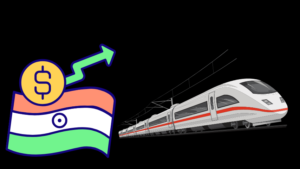Not only does Indian Railways serve as a vehicle, but it also plays a crucial role in the country’s destiny and significantly contributes to its Indian economic growth. As the world’s fourth-largest railroad network, it extends 68,584 kilometers, attracting millions of people and vast quantities of trade-bound goods. Moreover, the scale of its operations significantly enhances job opportunities in undeveloped and remote areas along its lines. The forces of the future are shaping India’s future economic history.
As India enters the 21st century, the Indian Railways is seeking new directions for multi-force developments, and its steadfast call for modernization has become a major factor in that process.
Economic Contributions of Indian Railways

1. Boosting GDP
The Indian Railways plays a crucial role in the overall economy. In 2024, the Indian Railways generated a gross operating income of 2.56 billion. This figure, as of right now, is unprecedented. In the years ahead, it is bound to thrive and grow very quickly—the budget for fiscal year 1994-95 is Rs 2.52 billion crore. Railroad communication and infrastructure construction are proceeding in an orderly fashion. We expect the railway sector to contribute up to 1.5% of India’s massive national output. This suggests that the railway sector’s enormous significance in today’s Indian economic growth scene is evident to anyone with half a brain.
2. Employment Powerhouse
It is one of the largest employers in the world. Indian Railways employs over 1.4 million people. In addition to the direct employment opportunities provided by railways, other industries such as construction, food supply, and transport companies generate millions more jobs. This makes the railways an economic force that affects almost every family in the country.
3. Supporting trade and industry.
Through efficient transportation of raw materials and finished goods, Indian Railways supplements industrial production, eliminates the cost of freight charges for overseas exports, and keeps up the pace with global competition. The introduction of DFCs for freight transport has brought further improvements in supply management, reducing logistics costs and increasing overall efficiency.
Modernization initiatives are driving growth
India’s railways are going through an amazing transition of outstanding economy and organization. This initiative not only increases operational efficiency; it also makes an actual contribution to Indian economic growth.
1. Electrification and Sustainability
Since 2014, the electrification of these 40,000 km of track has demonstrated India’s commitment to renewable green energy. By November 2024, 97% of the broad gauge track has undergone electrification, with unpowered traction engines now dominating this network. By eliminating the use of fossil fuels, this change significantly reduces emissions and operational costs.
2. High-Speed Trains
Vande Bharat, the Tejas Express, and other high-speed trains have brought revolutionary changes in passenger transport. With smart coaches equipped for future railway Internet of Things (IoT) applications, they operate at record-setting speeds combined with a level of comfort and safety that is genuinely world-class. This marks India’s transformation from traditional railway technology into advanced digital systems and makes trains a preferred mode of travel.
3. Dedicated Freight Corridors (DFCs)
DFCs have completely changed the dynamics in cargo services. By taking pressure off stranded passenger lines and streamlining supply chain implementation efficiency, they are forecast to help boost India’s GDP by ₹16,000 crore each year. These measures are bringing down logistical costs, putting industries in a position to compete more effectively globally.
4. Amrit Bharat Station Scheme
The Amrit Bharat Yojana will refurbish more than a thousand stations across India. These preparations will include Wi-Fi amenities, escalators, better lighting installations, and extra facilities for handicapped passengers.
5. Renewable Energy Adoption
Indian Railways is leading the way in renewable energy development by installing up to 200 megawatts of solar panels at 1498 stations. Indian Railways is now running iconic stations like Howrah and New Delhi entirely on solar power, aligning with India’s green energy objectives.
Digital Transformation in Indian Railways
Indian Railways is striving to deploy technology in order to improve efficiency and make the travel experience smoother for its passengers.
Online Booking Revolution
The Internet can not only respond to customer enquiries about ticket availability or arrival time, but it has also transformed the experience of booking tickets. And now, with Indian railways online booking with IRCTC Tatkal tickets offering real-time updates, digital platforms have made it easier than ever for everyone to plan their travel.
IRCTC Train Booking
A brand new interface for Indian Railways booking has been popular with urban and rural groups alike. After this digital transformation, not only has the passenger experience improved, but income generation rates have increased too.
AI and IoT integration
Indian Railways is leveraging AI and Internet of Things (IoT) technologies to optimize operations. From predictive maintenance of trains to AI-enabled ticketing systems, these advancements reduce delays and improve efficiency.
Role in Regional Development
Indian Railways is instrumental in bridging the urban-rural divide, fostering inclusive growth across the country.
1. Connecting Remote Areas
New railway lines cutting into the undeveloped interior have opened up economic prospects for the relatively backward rural and semi-urban regions. Old one-way roads meet two-way modern traffic. There is no better way to describe this connectivity than through photos that illustrate how it has brought prosperity back home.
2. Affordable transport for all.
Railways provide a cheap means of transport for both passengers as well as goods. Even the poorest can access reliable transportation with heavily subsidized fares, understanding that this type of asset contributes to their income. This is a tangible step toward promoting socio economic development. This accessibility plays a vital role in fotrain reservation bookingstering Indian economic growth, making it a tangible step toward promoting socio-economic development.
3. Promoting tourism
The railway has a significant responsibility in promoting tourism and linking famous scenic spots throughout China. Special trains, such as the Palace on Wheels or those like Bharat gaurav, for people from around the world to experience India’s unique combination of luxury and heritage, are well attended by both local guests and inbound foreign visitors.
Challenges Facing Indian Railways
While Indian Railways has made commendable progress, challenges remain:
- Ageing Infrastructure: Many tracks, bridges, and rolling stock require urgent upgrades.
- Funding Constraints: Despite increased budgets, the scale of necessary modernization demands significant investment.
- Overcrowding: High passenger demand often leads to overcrowded trains and stations.
- Safety Concerns: Accidents due to human error or technical failure highlight the need for robust safety measures.
Addressing these challenges is essential for sustaining Indian economic growth through railways.
Future prospects and vision
The government’s vision of Indian Railways might seem a bit ambitious. However, all of these seem likely to come to fruition, allowing everyone to dream light-heartedly and nap safely—from the comfort of their own bed. This vision is crucial for Indian economic growth, as it drives connectivity and fosters development across the nation.
Key Targets:
- 100 percent electrification: With full electrification in place by 2030, we can avoid emissions and eliminate fuel costs.
- High-Speed Rail Expansion: Projects such as the Mumbai-Ahmedabad bullet train will transform travel in India.
- Smart Stations: The goal is to upgrade an increasing number of stations with modern conveniences and digital integration.
- Better Freight Efficiency: Expanding DFCs is one beneficial way to take on greater freight volumes and thereby cut logistical costs further still.
Combined, these measures help to elevate India’s $5 trillion economy by placing the Indian Railways firmly at the front.
Conclusion
Far beyond its role as a transportation network, Indian Railways has more than established itself as a key infrastructure in Indian economic growth. Its contributions span employment, GDP growth, and linking the most remote parts of our country. Indeed, these contributions are unparalleled in both their scope and magnitude. With continued modernization, environmental protection, and digital reform, Indian Railways will usher in a new era of national prosperity.
Read the next blog: Digital Advertising Campaign






